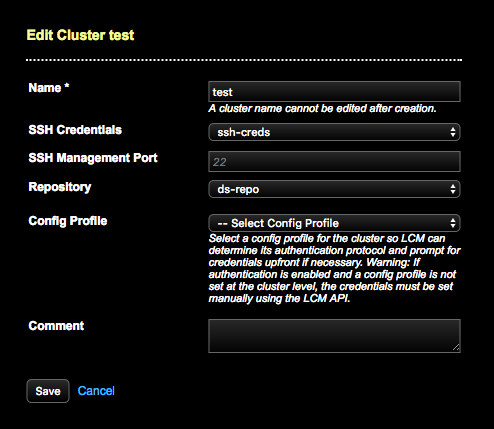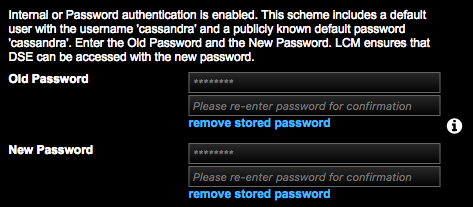Edit a cluster
Edit cluster details such as the configuration profile associated with a cluster and run an installation or configuration job to update a cluster.
Upgrade jobs are only applicable at the datacenter or node levels.
If authentication is enabled in the configuration profile associated with a cluster, prompts recommend changing the default password of the cassandra user.
After selecting a configuration profile that includes cassandra.yaml settings to enable the internal or password authentication scheme, the Add Cluster or Edit Cluster dialog prompts for old and new passwords for the built-in CQL user named cassandra.
The cassandra user is present by default in the internal authentication scheme, and has a publicly known default password of cassandra.
LCM changes the default cassandra password using the supplied password fields.
|
It is a security risk to leave the default cassandra password in place. Change the default password to prevent unauthorized access and avoid security breaches. |
-
Click Clusters from the Lifecycle Manager navigation menu.
-
Select the cluster to edit in the Clusters pane and choose Edit from the Clusters pane menu.
If the cluster name has an alias, the Display Name appears as a read-only field above the Cluster Name. To edit or remove the alias, see Change the display name of a cluster.


If the cluster does not currently have a configuration profile selected, an inline instruction prompts you to select one so that LCM can determine the authentication protocol and prompt for credentials upfront if necessary.
If authentication is not enabled within the selected configuration profile, there are no prompts for credentials. See authentication schemes supported in LCM for more details.
If authentication is enabled, the required credentials must be set prior to running the job. Not doing so causes LCM to fail registering the cluster automatically with OpsCenter monitoring. Set the credentials within the Add Cluster or Edit Cluster dialogs in the LCM UI, or set old and new passwords using the LCM API.
-
Make any changes, such as selecting a new Config Profile to associate with the cluster.
If prompted, enter the appropriate credentials for internal authentication. Enter the Old Password, New Password, and Confirm Password for the
cassandrauser if internal authentication is enabled as the default scheme (default).When editing a cluster that has authentication enabled in its configuration profile, the changed password fields are shown as already set. Click Change to change the password for the
cassandrauser again.
For an initial install, set the Old Password to
cassandra. Click the tooltip icon for more information.If a password has already been set but needs to be changed, click Change for the Old and New Passwords. Enter the old password and new passwords to update them.

Click the remove stored password link to explicitly remove stored credentials. After clicking Save, the credential is queued for removal. The LCM API no longer returns
old-password: true. The LCM API does not return stored passwords for obvious security reasons. Retaining or removing the stored password is at the discretion of your organization.
-
Click Save.
Next steps
Learn more about authentication schemes behaviors and limitations in LCM.
